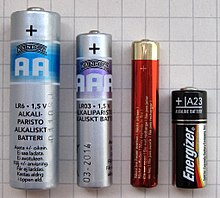difference in electrical potential between any two conductors or between a conductor and ground. A measure of the electric energy per electron that electrons can acquire and/or give up as they move between the two conductors.
This article needs additional citations for verification. (February 2018) (Learn how and when to remove this template message) |
This article may be expanded with text translated from the corresponding article in Norwegian. (May 2018) Click [show] for important translation instructions.
|
| Voltage | |
|---|---|
 Batteries are sources of voltage in many electric circuits. | |
Common symbols | V , ∆V , U , ∆U |
| SI unit | volt |
Derivations from other quantities | Voltage = Energy / charge |
| Dimension | M L2T−3I−1 |
Voltage, electric potential difference, electric pressure or electric tension is the difference in electric potential between two points. The difference in electric potential between two points (i.e., voltage) in a static electric field is defined as the work needed per unit of charge to move a test charge between the two points. In the International System of Units, the derived unit for voltage is named volt. In SI units, work per unit charge is expressed as joules per coulomb, where 1 volt = 1 joule (of work) per 1 coulomb (of charge). The official SI definition for volt uses power and current, where 1 volt = 1 watt (of power) per 1 ampere (of current). This definition is equivalent to the more commonly used 'joules per coulomb'. Voltage or electric potential difference is denoted symbolically by ∆V, but more often simply as V, for instance in the context of Ohm's or Kirchhoff's circuit laws.
Electric potential differences between points can be caused by electric charge, by electric current through a magnetic field, by time-varying magnetic fields, or some combination of these three. A voltmeter can be used to measure the voltage (or potential difference) between two points in a system; often a common reference potential such as the ground of the system is used as one of the points. A voltage may represent either a source of energy (electromotive force) or lost, used, or stored energy (potential drop).
